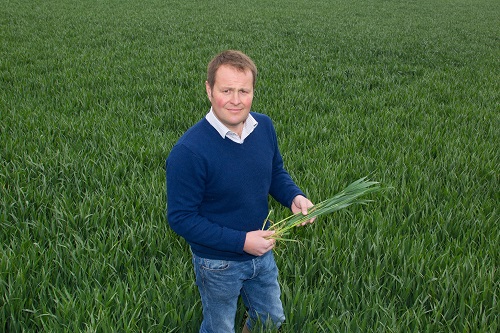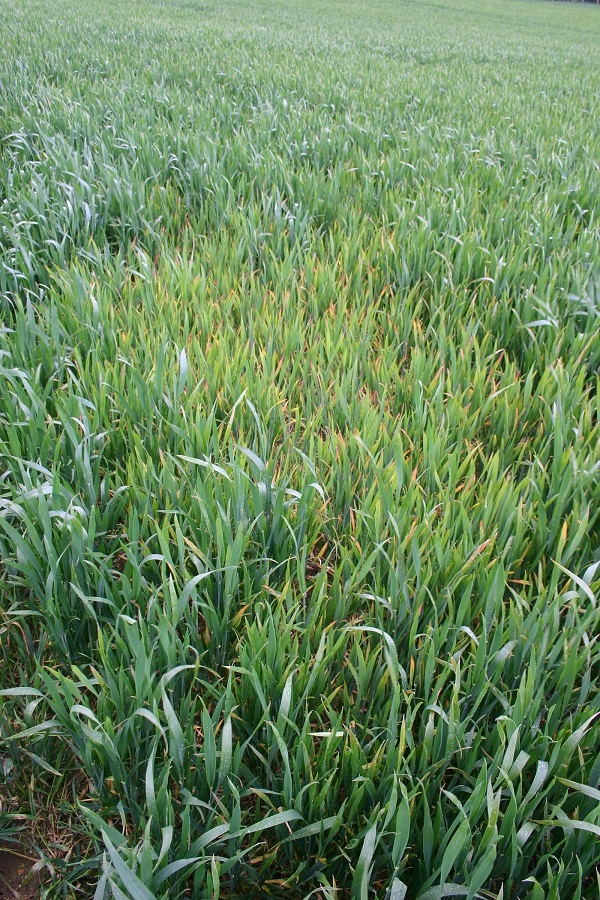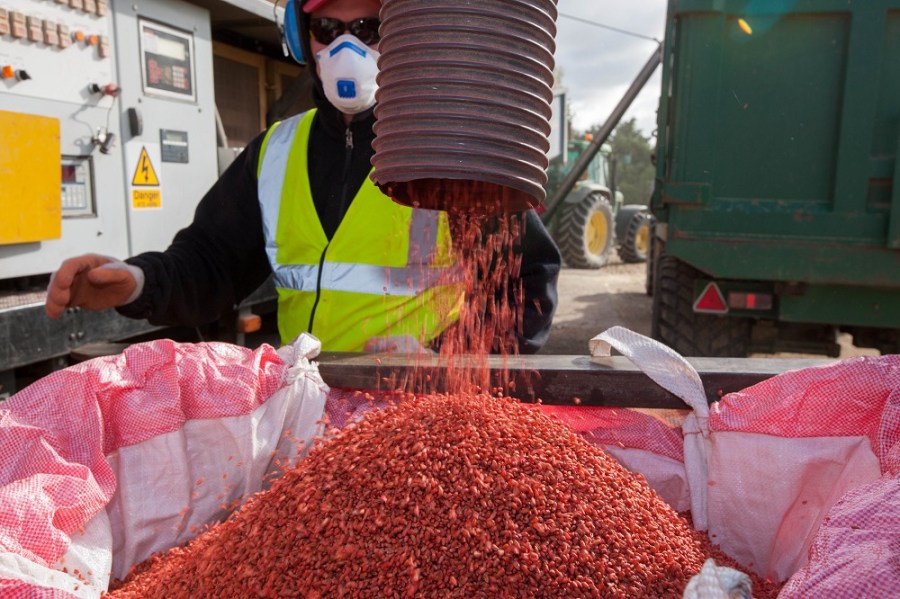Late-drilling used to mean a reduced threat from aphids and diseases, but warmer autumns mean there are now many more factors to address when deciding on seed treatments. CPM canvasses some opinions on their value.
When you apply neonicotinoids as a seed treatment, there’s less selection pressure for the evolution of resistance.
By Lucy de la Pasture
Late-drilled winter wheat has been widely adopted by many growers as part of their blackgrass strategy, but uncertainty around the weather at that time of the year means that getting the pest control strategy right is crucial.
In Lincs, grower Ben Atkinson farms 2,750ha of primarily combinable crops, with a six-year rotation including winter wheat, winter barley, winter oilseed rape, spring barley, spring beans and sugar beet – a rotation that has evolved in recent years due to issues with blackgrass.

Ben Atkinson believes a seed treatment to protect against BYDV is equally important in his later-drilled wheats.
“Until about five or six years ago, we were growing all winter crops. But the blackgrass pressure was getting steadily worse so we realised we had to bring more spring cropping into the equation,” he says.
Alongside this, he takes proactive measures to deal with the blackgrass issue, including varying cultivations and using low disturbance subsoil legs when drilling the winter crop.
“We’re only cultivating the top inch or so of soil. So we’re not stirring up other problems and bringing up seed from a depth,” he explains.
When it comes to protecting his winter wheat in the early stages, Ben Atkinson also employs a comprehensive set of chemical controls. But to tackle BYDV, he says that it‘s seed treatment that‘s the crucial tool for growers who have moved to late drilling.

Deter is effective on both vectors of BYDV, the bird cherry oat aphid and the grain aphid.
“If we’re drilling in late Oct, the weather window soon shuts and it can be difficult to get on with the sprayer, especially when it comes to protecting against BYDV. We use Deter (clothianidin) on our wheat seed to protect against the disease, and with late-drilled wheat it is arguably more essential now than ever.”
In the face of the European Commission’s proposed ban on neonicotinoids in field crops, Ben Atkinson’s assertion takes on a starker light. Without seed treatments, growers will face a paucity of options when it comes to pest control strategies in late-drilled wheat. According to Dr Steve Foster, entomologist at Rothamsted Research, the consequences for those growing late-planted wheat could be severe.
“In a late sown crop, growers can have less ability to spray. So having a diversity of options – and something you can fall back on – as part of your integrated pest management is so important.”
Steve Foster warns that a ban would unnecessarily reduce this diversity, resulting in a greater pressure on the remaining insecticides. With this comes an increased risk of resistance building up in pests – something that could make BYDV an even bigger problem for growers.
“When seed treatments were lost in OSR, extra pressure was put on pyrethroid insecticides and we saw resistance develop in cabbage stem flea beetle,” he says.
“I think the scenario will be the same for aphids if the ban occurs. We’ve already seen resistance to pyrethroids in grain aphids, and as the pressure on active ingredients increases, greater resistance is inevitable.
″If we reach the point where we have a higher level of resistance in aphids, then the pyrethroids would probably stop working and BYDV would build up in the cereal crops.”
And according to Steve Foster, his latest research reinforces his view.
“When you apply neonicotinoids as a seed treatment, there’s less selection pressure for the evolution of resistance compared to a foliar application. And that flies in the face of what’s happening, where we may be losing the seed treatments and falling back on foliar insecticides.”
This is even more significant considering seed treatments can grant greater protection against BYDV due to spraying restrictions, as Tim Nicholson, Bayer’s commercial technical Manager points out.
“With a pyrethroid programme, when you’re using something like lambda-cyhalothrin (Hallmark), you have a 5m compulsory arthropod barrier. To ensure control against aphids up to the field edge, growers need seed treatments.
“Only Deter will deal with both vectors of BYDV, the bird cherry oat aphid and the grain aphid. With resistance to pyrethroids already been seen in the latter, it only increases the importance of seed treatments as part of a grower’s toolkit.”
Tim Nicholson also highlights that aphids aren‘t the only pest that seed treatments can offer activity against in later-drilled wheat.
“Deter has also been shown to reduce slug damage as well. Late-drilled crops are more likely to be sitting in wet soil conditions, conducive to slug activity and increasing the risk of grain hollowing,” he says.
“Treatments need to be part of an integrated slug control programme, including drilling to 4cm depth, a fine seedbed with rolling and slug pellets, if needed. However, with late-drilled wheat, growers may not have the time to apply slug pellets to the seedbed and wait for them to reduce the slug population.
Similarly, if you’re drilling later into moist soil, there’s an increased chance you won’t be able to roll because the soil could get wet after drilling. By using a seed treatment, you can have some activity against slugs in case you can’t get on with the rolls before the weather breaks down.”
The new metaldehyde stewardship guidelines introduce a 10m buffer-zone requirement, which is another area where a Deter seed treatment may come into its own, protecting otherwise potentially untreated headlands, he adds.
Ben Atkinson agrees that the weather plays a huge role in the good establishment of late-drilled wheat, and that this can vary from year to year. But he concludes that growers can still take measures to make the best of the situation.
“Some years you get a really nice opportunity to deploy your late drilling, but in other years, if the weather goes against you, late drilling can be disastrous.
“That’s why the most important day in a crop’s life is the day you plant it, get it into a good seedbed and off to a good start. To do that, we have to make sure we make the most of cultural controls and the armoury of tools we have. Seed treatment is a big, big part of that.”
Neonics under threat
Growers and the wider arable industry have a short window of opportunity to help influence the Government’s position on neonicotinoids ahead of discussions in the EU.
In March of this year, the European Commission tabled new proposals that would ban the use of certain neonicotinoid seed treatments in non-bee-attractive crops such as wheat, barley, sugar beet and vegetables. The proposals are due to be discussed at the July meeting of the Standing Committee of Plants Animals, Food and Feed in Brussels.
Three things you can do to help fight these proposals.
- Adopt stewardship measures – particularly minimise dust and uncovered drilled seed or spillages.
- Write to local MPs and MEPs, as well as Government Ministers to explain why seed treatments are important.
- Engage on social media #saveourseedtreatments
Vibrance by name, vibrant by nature
According to Mark Bullen, seeds and seedcare manager for Syngenta, latest generation SDHI fungicides are first and foremost for controlling disease. But increasingly research is uncovering a range of other beneficial side effects, over and above disease control.
“In the case of the new SDHI-based seed treatment Vibrance Duo (fludioxonil and sedaxane), newly available this autumn, its prime role is to protect emerging seedlings against diseases that jeopardise crop establishment,” he explains.
“However, there is growing evidence that its SDHI active ingredient, sedaxane, also provides added crop health benefits – particularly during dry conditions.
“Results released previously on sedaxane have shown it led to increased root growth, even in non-diseased seed. Deeper roots provide improved scavenging for soil moisture and nutrients. But further research at the University of Nottingham has also now shown sedaxane to produce a benefit to photosynthesis in wheat seedlings grown in drought conditions.”
Mark Bullen explains that normally, drought-stressed plants become less efficient at photosynthesis, which converts carbon dioxide into the sugars that provide fuel for crop growth. But carbon dioxide conversion in drought-stressed wheat treated with sedaxane was found to be just as efficient as in un-stressed wheat, he notes.
“Sedaxane was found to turn up the activity of certain beneficial genes. In our own trials, we‘ve seen that Vibrance Duo has given better crop establishment during colder weather. Now, these drought findings could prove valuable when establishment conditions are dry.
“With unpredictable weather patterns, growers need to think about utilising these types of wider benefits. They could have contributed to some of the substantial yield increases seen with Vibrance Duo in trials.
“As well as boosting yield by more than 0.5 t/ha compared with untreated seed, Vibrance Duo has also given an average yield increase of nearly 0.15 t/ha compared with an alternative seed treatment in trials in Northern Europe.”
Pre-empting take-all
Take-all is a disease that has caught the attention this summer. The tell-tale white heads have become blindingly obvious in infected fields as compromised crops battle with dry conditions.
Traditionally, late drilling has been the main route to manage and control take-all as colder soils naturally reduce biological activity of the take-all inoculum.
“Drilling later, after 15 Oct, where growers are able to do so, is the most positive action that growers can take to mitigate the risk of take-all,“ says Wynnstay’s seed manager, Richard Torr.
This isn’t always possible as growers have to consider many factors when it comes to drilling dates, and sometimes it’s just not possible to put every field in at the ideal time to control every pest and disease.
“In this instance, a specialist seed treatment is the next-best control option, meaning timing isn’t so paramount,” he adds.
“Targeted take-all seed treatments are essentially an insurance policy against the effects of the disease, whether delayed drilling dates can be observed or not,” explains Certis’ technical manager, Adrian Sisson.
“They offer a zone of protection around young roots. This enables them to become established and robust enough to cope with the pressures of the take-all inoculum once they have grown out of this protected zone.
“This provides flexibility and works in conjunction with other control measures to reduce disease risk whilst the inoculum pressure is high. Trials have shown that a specialist seed treatment, like Latitude (silthiofam), has the potential to give a yield response of up to 0.55 t/ha, meaning farmers can mitigate the effects of the disease where second wheats are grown,“ he says.
Micronutrients give fair reward
The need for zinc and other micronutrients in cereal crops is widely recognised, but because requirements are small and availability is often determined by a range of interacting factors, deficiencies often go unaddressed, believes Andrew Robinson, manager at Heathcote Farms in Beds.
Looking more closely at his crops nutritional requirements, zinc has become a core part of his ambition to regularly produce high yielding crops across 1150ha of predominantly Hanslope series clay.
The need for zinc is perhaps surprising given the farm’s soil profile, which suggests micronutrients should be readily available. Zinc deficiency is usually associated with sandy soils with high pH and phosphate status (Index 5, 6, or 7). Manganese is another micronutrient he has found to be in deficit, despite the soil composition and pH balance suggesting it should be freely available.
To counter the effects of manganese deficiency, he typically applies three applications of a foliar solution during the spring as a tank-mix with fungicides. The cost is roughly £35/ha each season, but one he considers worthwhile.
“In my experience, it‘s money well spent. The return more than justifies the expense,” says Andrew Robinson.
But to improve zinc availability, he uses a seed treatment, Radiate (7.0% N, 8.5% Zn, bio-stimulant), which is applied in conjunction with a standard fungicidal seed treatment. He has linked the improvement in yields to the greater root mass of treated seed. This correlation led him to investigate the possible effects of other nutrients known to promote root mass, such as applying phosphate at drilling. However, he found zinc gave the greatest response.
“We tried Radiate in 2011/12 on the advice of our seed-dresser. I was sceptical at the time, but after comparing the root weights of treated and untreated crops at the start of spring, it was clear something was happening,” he says.
“We followed it through to harvest with the treated crop yielding an average 0.37t/ha more than the untreated. All our home-saved wheat and barley seed is now treated with Radiate,” he adds.
He has come to regard it as a form of risk management since the benefits of bigger roots are greater in dry year.
“You never know what sort of season it will turn out to be when you drill the crop, but experience has taught me that complacency is rarely rewarded. At about £10/ha it is another worthwhile spend.”




